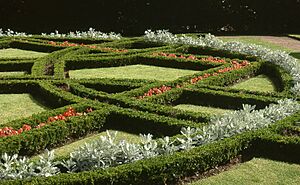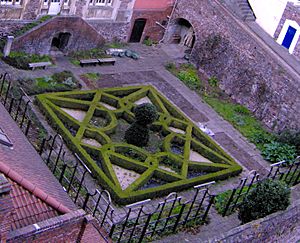Knot garden facts for kids

A knot garden is a special type of garden that looks like a beautiful, woven pattern. Imagine a fancy carpet or a braided design, but made with plants! These gardens are usually square and are filled with different kinds of plants, especially ones that smell nice or can be used in cooking.
Some common plants you might find in a knot garden are germander, marjoram, thyme, lemon balm, hyssop, chamomile, and rosemary. Many knot gardens today use small, green hedges made from a plant called box (Buxus sempervirens). These hedges are easy to trim into cool shapes, like tiny fences, and they stay green all year, even in winter. The paths between the plant patterns are often made of fine gravel.
Originally, knot gardens didn't have these low box hedges. Gardens with hedges like these are sometimes called parterres, which are another type of formal garden. Most knot gardens from the Renaissance period were made of square sections. A small garden might have one section, while bigger gardens could have six or eight.
Contents
What Makes a Knot Garden Special?
Knot gardens get their ideas from old designs used inside homes, like patterns on carpets, wall hangings, or cushions. They are often made to be looked at from above, so you can really see the cool, tangled patterns. These patterns are usually made by carefully trimming box plants (Buxus sempervirens) to create an interlocking design, almost like threads weaving together.
Unlike French parterres, knot gardens are usually smaller. Their hedges often have different heights, creating junctions that show how the 'threads' of the design cross over or knot together.
Where Can You Find Knot Gardens?

Knot gardens first became popular in England during the time of Queen Elizabeth I.
Some very old knot gardens have been covered over by grass or other landscaping over time. However, you can sometimes still see the original shapes as gentle bumps or dips in the ground today. An example of this is the early 17th-century garden at Muchalls Castle in Scotland.
Today, knot gardens are found in many formal gardens around the world, especially in places with mild climates. Some famous examples include:
- Alexandra Hicks Herb Knot Garden, University of Michigan, USA
- Antony House, Cornwall, England
- Anzac Square, Dunedin, New Zealand
- Astley Castle, Warwickshire, England
- Brooklyn Botanic Garden, New York City, USA
- Cleveland Botanical Garden, USA
- Hatfield House, Hertfordshire, England
- Little Moreton Hall, Cheshire, England
- Red Lodge Museum, Bristol, England
- St Fagans, South Wales
- Sudeley Castle, Cotswolds, England
A knot garden is even mentioned in one of Shakespeare's plays, called Love's Labour's Lost.
Images for kids
-
Knot Garden at Sudeley Castle, Gloucestershire, England
-
Garden Museum, London, England
-
Little Moreton Hall Knot Garden, Cheshire, England
-
Knot Garden at Moseley Old Hall, Wolverhampton, England
See also
 In Spanish: Jardín de nudo para niños
In Spanish: Jardín de nudo para niños





